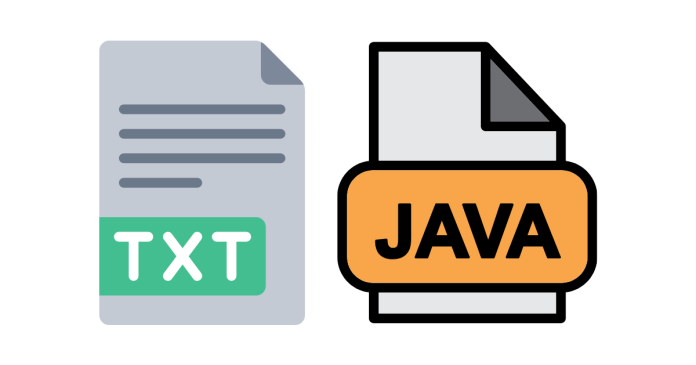To read a plain text file in Java, you can use various approaches. Below are some commonly used methods with examples:
1. Using BufferedReader
This is a simple and efficient way to read a text file line by line.
Code Example:
import java.io.BufferedReader;
import java.io.FileReader;
import java.io.IOException;
public class ReadFileExample {
public static void main(String[] args) {
String filePath = "example.txt"; // Replace with your file path
try (BufferedReader br = new BufferedReader(new FileReader(filePath))) {
String line;
while1 != null) {
System.out.println(line);
}
} catch (IOException e) {
e.printStackTrace();
}
}
}
- Explanation:
FileReaderreads the file character by character.BufferedReaderimproves performance by buffering the input and allows reading the file line by line withreadLine().
2. Using Files Class (Java NIO)
The Files class provides modern and concise methods to read the entire file content at once.
Code Example:
import java.io.IOException;
import java.nio.file.Files;
import java.nio.file.Paths;
import java.util.List;
public class ReadFileExample {
public static void main(String[] args) {
String filePath = "example.txt"; // Replace with your file path
try {
List<String> lines = Files.readAllLines(Paths.get(filePath));
for (String line : lines) {
System.out.println(line);
}
} catch (IOException e) {
e.printStackTrace();
}
}
}
- Explanation:
Files.readAllLines()reads the file into aListof strings, where each string represents a line in the file.- Suitable for small to medium-sized files.
3. Using Scanner Class
Scanner is another simple way to read a file, commonly used for reading structured data.
Code Example:
import java.io.File;
import java.io.FileNotFoundException;
import java.util.Scanner;
public class ReadFileExample {
public static void main(String[] args) {
String filePath = "example.txt"; // Replace with your file path
try (Scanner scanner = new Scanner(new File(filePath))) {
while (scanner.hasNextLine()) {
String line = scanner.nextLine();
System.out.println(line);
}
} catch (FileNotFoundException e) {
e.printStackTrace();
}
}
}
- Explanation:
Scannerreads the file line by line usinghasNextLine()andnextLine().- Suitable for parsing and processing text line by line.
4. Using FileInputStream and InputStreamReader
This method is useful for reading files with a specific character encoding.
Code Example:
import java.io.FileInputStream;
import java.io.InputStreamReader;
import java.io.BufferedReader;
import java.io.IOException;
public class ReadFileExample {
public static void main(String[] args) {
String filePath = "example.txt"; // Replace with your file path
try (BufferedReader br = new BufferedReader(new InputStreamReader(new FileInputStream(filePath), "UTF-8"))) {
String line;
while1 != null) {
System.out.println(line);
}
} catch (IOException e) {
e.printStackTrace();
}
}
}
- Explanation:
- Use
InputStreamReaderto specify the character encoding (e.g., UTF-8). - Suitable for files with non-default encodings.
- Use
5. Using Files.lines() (Java 8 and Above)
This approach streams the file lines for efficient processing, especially for large files.
Code Example:
import java.nio.file.Files;
import java.nio.file.Path;
import java.nio.file.Paths;
import java.io.IOException;
import java.util.stream.Stream;
public class ReadFileExample {
public static void main(String[] args) {
String filePath = "example.txt"; // Replace with your file path
try (Stream<String> lines = Files.lines(Paths.get(filePath))) {
lines.forEach(System.out::println);
} catch (IOException e) {
e.printStackTrace();
}
}
}
- Explanation:
Files.lines()creates a stream of lines from the file.- Ideal for processing large files efficiently.
6. Reading Entire File as a String
If you want to read the entire file content into a single String:
Code Example:
import java.nio.file.Files;
import java.nio.file.Paths;
import java.io.IOException;
public class ReadFileExample {
public static void main(String[] args) {
String filePath = "example.txt"; // Replace with your file path
try {
String content = new String(Files.readAllBytes(Paths.get(filePath)));
System.out.println(content);
} catch (IOException e) {
e.printStackTrace();
}
}
}
- Explanation:
Files.readAllBytes()reads all the bytes from the file into abyte[], which is then converted to aString.
Best Practices
- Close Resources: Always use
try-with-resourcesto automatically close file-related resources. - Exception Handling: Handle exceptions properly to avoid runtime errors.
- Character Encoding: Be mindful of the file’s encoding to avoid issues with special characters.



